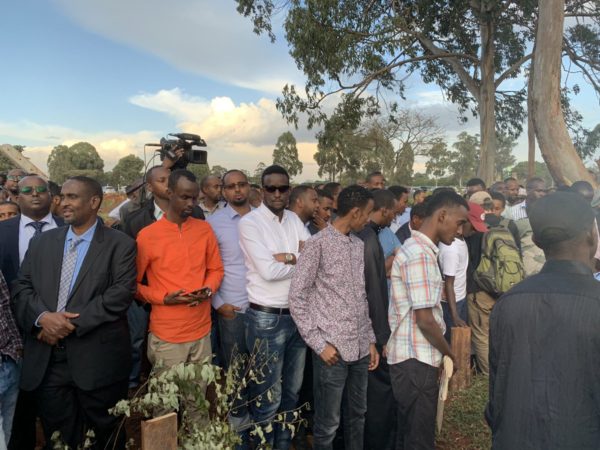
Kenyans are rightly criticizing The New York Times‘ publication of victims’ photos from the January 15 Al Shabaab terrorist attack on Dusit D2 Hotel and Secret Gardens restaurant, Riverside Complex, Nairobi, which claimed 21 lives, according to an updated report by The Star. The graphic photos were posted on Twitter and swiftly drew backlash. The American media house subsequently had its photo handle, @NYTphoto, suspended by Twitter for violating its guidelines.
New York times photo account suspended- after outrage over posting apparent images of the dead from #RiversideAttack in Kenya. pic.twitter.com/kE7zp781rU
— FERDINAND OMONDI (@FerdyOmondi) January 15, 2019
The publication of the photos represented a Western media double standard when it came to negative news from Africa: unlike their coverage of the many mass shootings in the US during which they have never published graphic images of victims, the Times did not hesitate to do this in covering the Dusit attack. Shortly after it began being called out, with more than 12,000 people having signed a Change.org petition to force the paper to take down the photos, it made a tweet that basically justifies the decision.
We have heard from some readers upset with our publishing a photo showing victims after a brutal attack in Nairobi. We understand how painful this coverage can be, and we try to be very sensitive in how we handle both words and images in these situations. https://t.co/Qjm0qBMaF3 pic.twitter.com/1sqgTnnVKW
— The New York Times (@nytimes) January 15, 2019
But Twitter users were having none of it.
@nytimes, you have provided to our enemies a front row seat to the mayhem they have created. You are now part and parcel of this story. And let history note that on this day, you did not stand with Kenya. We will remember and do what we do best, revisit.
— Wanja Kimandi (@wanjar) January 15, 2019
Shame on you. Be considerate to the families who are Still in shock.
— sitawa Renee (@sitawarene) January 15, 2019
we see some of these people everyday we go to work. They are not just strangers from a far off country. Show both those who have died and those who have survived some respect. It’s the responsible way to report.
— Wanjugu (@MissNderu) January 15, 2019
Please take pic down. I never see pictures of dead euros or Americans when you cover their disasters. Respect please.
— Susan Nyall (@asali234) January 15, 2019
If anyone has ever lost sight as to how the west views black people, then this is your wake up cal before you lull back to slumber. It has not changed and it will never change. Love your people my people, you are all alone on this starship earth.
— Rhapsody in Black (@AndrewKabena) January 15, 2019
I encourage everyone to report the @nytimes for their flagrant disregard for human life. It is unethical and unacceptable to publish these images and it would NOT happen if the deceased were white North Americans.
— Sarah Kastner (@SarahKastner) January 15, 2019
I strongly recommend that government of Kenya ban The New York Times from undertaking any business in Kenya to serve as a lesson to western propagandists.
A few years back we were here with CNN.
Humanity must be a priority!#RiversideAttack #Nairobi #DusitHotelAttack
— James Kiragu (@OfficialKiragu) January 15, 2019
Showing images of the dead is sensational & disrespectful. If the same had occurred in the U.S., you would never show images of the victims. This is an ethical violation & double standard with complete disregard for these victims & families. Pls take these images down ASAP!
— Pia Basu (@Pia_Basu) January 15, 2019
……an office complex “housing foreign companies”? Really @nytimes ? REALLY????
It’s not 1920, we see the narrative that you are trying to push and the agenda behind it. What, your staff too racist to just type “housing several companies”? #racist content much?— The MillennialPreneur (@WendyAydah) January 15, 2019
Between this story by a UK media & those photos by New York times, as black Africans, we are nothing but a statistic to western media.
How do we earn our respect, how do we teach others to respect us and treat us as equals?#14Riverside#RiversideAttackhttps://t.co/JkiKYsmaYm
— Sam Gichuru (@SamGichuru) January 16, 2019
Using the hashtag #deportkimiko, some Kenyans are pushing for the removal of The New York Times‘ East Africa bureau chief, the Paris-born Kimiko de Freytas-Tamura, less than four months into her appointment. The controversial report of the attack—which emphasized that the complex houses foreign companies without mentioning that it actually houses many more Kenyan companies—had been written by her, and she had been among the first to tweet it with the images. Her initial response to the criticism had been “dismissive.”
A luxury hotel and an office complex housing foreign companies in Nairobi came under heavy attack by Shabab militants on Tuesday, on the eve of a verdict in the trial of 4 men charged with helping the group stage a similar assault 5 years ago https://t.co/SQ63iNQ0Zo
— The New York Times (@nytimes) January 15, 2019
I am all in favour of this #DeportKimiko tag, not for the immediate catharsis it provides to an angry public, but because it highlights a greater issue. I have always said that the ecosystem of global media sending foreign press to “cover Africa” is a dangerous one.
— Jim Chuchu (@jimchuchu) January 16, 2019
We will not entertain arrogance from international journalists who do not respect our values. #someonetellNYtimes #deportKimiko https://t.co/TL0ZSMiu0c
— Mbugua Brian (@MbuguaBrian3) January 15, 2019
She should be blocked from working in East Africa both @UKenyatta @KagutaMuseveni and @MagufuliJP should take note of her arrogance and block her work permit immediately.
— Proverbs 5:3 (@jackndunya) January 15, 2019
Kimiko, who has been described by Hapa Kenya as someone who “doesn’t respect black bodies and Kenya to some extent,” had returned with a softer stance.
I actually did though apologies if I sounded dismissive. I wasn’t. But writers don’t know til the piece is published what photos are being used. Thanks
— Kimiko de Freytas-Tamura (@kimidefreytas) January 15, 2019
This is a profoundly tragic development. We commiserate with Kenyans.
Kenyans we are one, God with us, a very safe country pic.twitter.com/SYUudIh3lZ
— Katambo (@kiokobr) January 15, 2019
Read more about it on Africanews and Daily Nation.









COMMENTS -
Reader Interactions